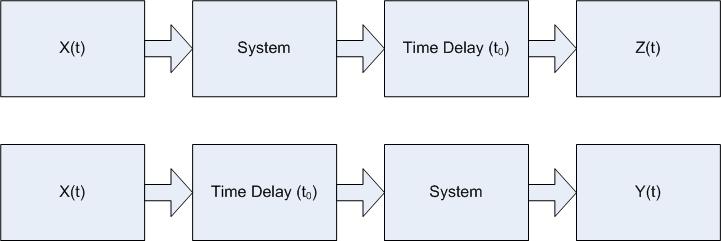| Line 1: | Line 1: | ||
| + | =How to determine if a system is time-invariant (using the definition)= | ||
To determine if a system is time invariant subject the input to a time delay <math>t_{0}</math> (where <math>t_{0}</math> is an element of the real numbers) then feed delayed input through a system. We will call this result z(t). Then take the same input and feed it thorough the same system as used in the first part. Next the output of the system to the same time delay as in the first part. We will call the result of this y(t). If y(t) and z(t) are equal then the system is time invariant. If they are not equal then the system is time variant. | To determine if a system is time invariant subject the input to a time delay <math>t_{0}</math> (where <math>t_{0}</math> is an element of the real numbers) then feed delayed input through a system. We will call this result z(t). Then take the same input and feed it thorough the same system as used in the first part. Next the output of the system to the same time delay as in the first part. We will call the result of this y(t). If y(t) and z(t) are equal then the system is time invariant. If they are not equal then the system is time variant. | ||
| Line 10: | Line 11: | ||
Again if Z(t) = Y(t) then the system is TI. If they are not equal then the system is time variant. | Again if Z(t) = Y(t) then the system is TI. If they are not equal then the system is time variant. | ||
| + | ---- | ||
| + | |||
| + | ---- | ||
| + | [[Homework_3_ECE301Fall2008mboutin|Back to HW3]] | ||
| + | |||
| + | [[Main_Page_ECE301Fall2008mboutin|Back to ECE301 Fall 2008]] | ||
Latest revision as of 12:00, 30 January 2011
How to determine if a system is time-invariant (using the definition)
To determine if a system is time invariant subject the input to a time delay $ t_{0} $ (where $ t_{0} $ is an element of the real numbers) then feed delayed input through a system. We will call this result z(t). Then take the same input and feed it thorough the same system as used in the first part. Next the output of the system to the same time delay as in the first part. We will call the result of this y(t). If y(t) and z(t) are equal then the system is time invariant. If they are not equal then the system is time variant.
Here is a block diagram of the process:
Again if Z(t) = Y(t) then the system is TI. If they are not equal then the system is time variant.


